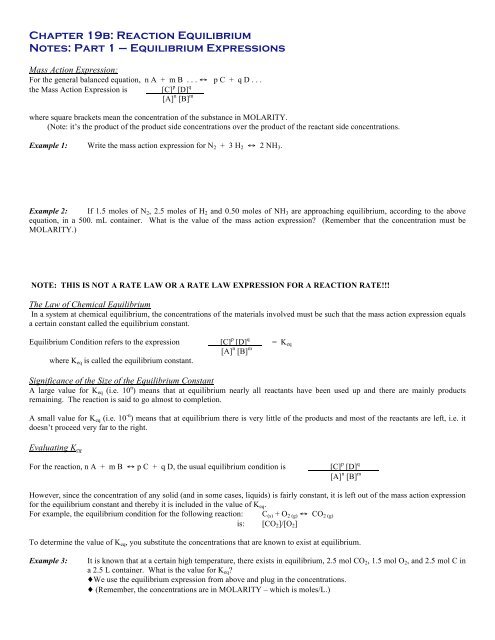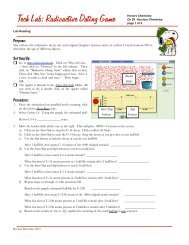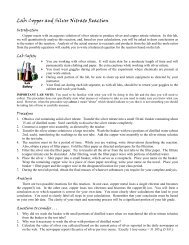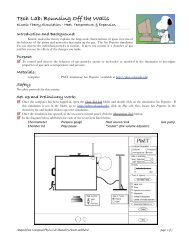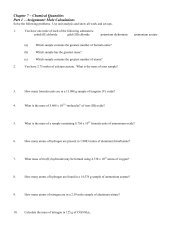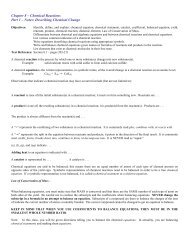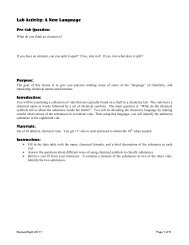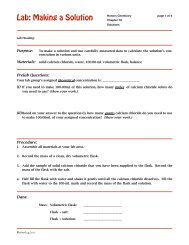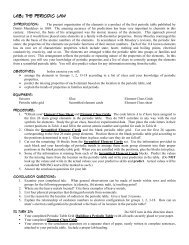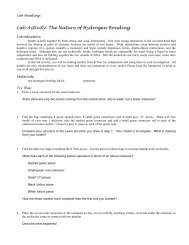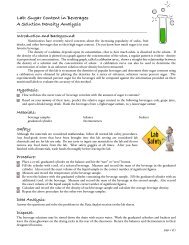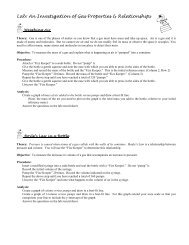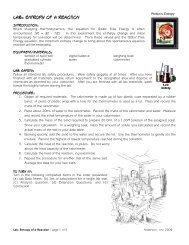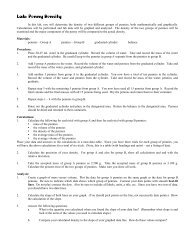Chapter 19B Notes - Honors Chemistry Coursework
Chapter 19B Notes - Honors Chemistry Coursework
Chapter 19B Notes - Honors Chemistry Coursework
Create successful ePaper yourself
Turn your PDF publications into a flip-book with our unique Google optimized e-Paper software.
<strong>Chapter</strong> 19b: Reaction Equilibrium<br />
<strong>Notes</strong>: Part 1 – Equilibrium Expressions<br />
Mass Action Expression:<br />
For the general balanced equation, n A + m B . . . p C + q D . . .<br />
the Mass Action Expression is [C] p [D] q<br />
[A] n [B] m<br />
where square brackets mean the concentration of the substance in MOLARITY.<br />
(Note: it’s the product of the product side concentrations over the product of the reactant side concentrations.<br />
Example 1: Write the mass action expression for N 2 + 3 H 2 2 NH 3 .<br />
Example 2: If 1.5 moles of N 2 , 2.5 moles of H 2 and 0.50 moles of NH 3 are approaching equilibrium, according to the above<br />
equation, in a 500. mL container. What is the value of the mass action expression? (Remember that the concentration must be<br />
MOLARITY.)<br />
NOTE: THIS IS NOT A RATE LAW OR A RATE LAW EXPRESSION FOR A REACTION RATE!!!<br />
The Law of Chemical Equilibrium<br />
In a system at chemical equilibrium, the concentrations of the materials involved must be such that the mass action expression equals<br />
a certain constant called the equilibrium constant.<br />
Equilibrium Condition refers to the expression [C] p [D] q = K eq<br />
[A] n [B] m<br />
where K eq is called the equilibrium constant.<br />
Significance of the Size of the Equilibrium Constant<br />
A large value for K eq (i.e. 10 n ) means that at equilibrium nearly all reactants have been used up and there are mainly products<br />
remaining. The reaction is said to go almost to completion.<br />
A small value for K eq (i.e. 10 -n ) means that at equilibrium there is very little of the products and most of the reactants are left, i.e. it<br />
doesn’t proceed very far to the right.<br />
Evaluating K eq<br />
For the reaction, n A + m B p C + q D, the usual equilibrium condition is<br />
[C] p [D] q<br />
[A] n [B] m<br />
However, since the concentration of any solid (and in some cases, liquids) is fairly constant, it is left out of the mass action expression<br />
for the equilibrium constant and thereby it is included in the value of K eq .<br />
For example, the equilibrium condition for the following reaction: C (s) + O 2 (g) CO 2 (g)<br />
is: [CO 2 ]/[O 2 ]<br />
To determine the value of K eq , you substitute the concentrations that are known to exist at equilibrium.<br />
Example 3:<br />
It is known that at a certain high temperature, there exists in equilibrium, 2.5 mol CO 2 , 1.5 mol O 2 , and 2.5 mol C in<br />
a 2.5 L container. What is the value for K eq ?<br />
We use the equilibrium expression from above and plug in the concentrations.<br />
(Remember, the concentrations are in MOLARITY – which is moles/L.)
(Note: the carbon is omitted because it is solid and its concentration does not change.)<br />
Example 4:<br />
(a) What is the value of the mass action expression for the equation: 4 NH 3 + 5 O 2 4 NO + 6 H 2 O, when, in a<br />
2.50 L container, there are 7.50 mol NH 3 , 5.00 mol O 2 , 25.0 mol NO, and 2.50 mol H 2 O?<br />
(b) What is the value of mass action expression if, at equilibrium, the concentration of the NO has increased to<br />
11.0M?<br />
Example 5:<br />
For the system 4 H 2 (g) + Fe 3 O 4 (s) 3 Fe (s) + 4 H 2 O (g) , find K eq if, initially, there is only 1.60 M H 2 and 100. g<br />
Fe 3 O 4 and if, at equilibrium, the concentration of H 2 is 1.00 M.<br />
<strong>Chapter</strong> 19b: Reaction Equilibrium<br />
<strong>Notes</strong>: Part 2 – More Equilibrium Expressions<br />
Determining Equilibrium Concentrations from Equilibrium Constants<br />
Example 1: How many moles of CO 2 would exist in equilibrium with 1.0 mole H 2 , 2.0 moles CO, and 3.0 moles H 2 O if K eq = 1.60<br />
for the system H 2 (g) + CO 2 (g) H 2 O (g) + CO (g) at 986 o C in a 500. mL container?<br />
Determining Equilibrium Concentrations from Initial Concentrations<br />
Steps:<br />
- Select the substance in the equation with the lowest coefficient in front of it and<br />
o if it is on the left side of the equation, make it into a statement, “Let ‘x’ M of it be used up”.<br />
or<br />
o if it is on the right side of the equation, make it into the statement, “Let ‘x’ M of it be produced”.<br />
- Write down the concentrations used up or produced of all the other substances, using the coefficients in the balanced<br />
equation.<br />
For example: If the equation is 4 HCl + O 2 2 Cl 2 + 2 H 2 O, you would “Let x M of O 2 be used up” and also “4x M of HCl would<br />
also be used up.” You would then say “Let 2x M of Cl 2 and 2x M of H 2 O are then produced.”<br />
- In order to write the reaction equilibrium concentrations in terms of ‘x’, you either<br />
o (i) subtract the concentration used up from the initial concentrations given<br />
or<br />
o (ii) add the concentration produced to the initial concentration given (if any).<br />
- Substitute the above equilibrium concentrations and the given value for Keq into the equilibrium condition expression and<br />
solve for ‘x’.<br />
- To determine the final answer for the equilibrium concentrations go back to the third step and put in the value for ‘x’.
Example 2: At a certain temperature, K eq = 49.0 for the reaction A (g) + B (g) 2C (g) . If, initially, 5.00 mol A and 5.00 mol B are<br />
placed in a 5.00 L container, what will be the equilibrium concentration of C? How many moles of A will be left?<br />
Example 3: K eq = 81.0 at a certain temperature for the reaction 4 A (g) + B (s) 2 C (g) + 2 D (g) . If, initially, there were 7.00 moles<br />
of A and 7.00 moles of B in a 500.0 mL container, what would be the equilibrium concentration of C?<br />
<strong>Chapter</strong> 19b: Reaction Equilibrium<br />
<strong>Notes</strong>: Part 3 – Solubility Product Constant<br />
What is K sp and How Do I Find It?<br />
Soluble is a relative term. Most insoluble ionic solids are actually soluble in water to a limited extent. These solids<br />
dissociate slightly in water. The compound silver chloride dissociates slightly in water to silver ions (Ag + ) and chloride ions (Cl - ). An<br />
equilibrium is established in the saturated solution between the solid and the ions in solution. The equation for this equilibrium is:<br />
AgCl (s) Ag + (aq) + Cl - (aq).<br />
The above equation can be represented mathematically by a constant, K eq , called the equilibrium constant. By definition, this<br />
constant is equal to the molar concentration of the products divided by the molar concentration of the reactants. The concentration of<br />
each ion is raised to a power equal to the coefficient of the ion in the balanced equation. This constant can be expressed as follows:<br />
K eq = [products] = [Ag+] [Cl-]<br />
[reactants]<br />
[AgCl]<br />
The concentration of a pure solid, such as AgCl, is a constant. Since both terms, AgCl and K eq , are constants, they may be<br />
multiplied together to form a new constant, which is known as the solubility product constant, or the K sp .<br />
[Ag + ] [Cl - ] = K eq [AgCl] = K sp<br />
The solubility product constant, K sp , is the product of the concentration of the ions in a saturated solution raised to the power of the<br />
coefficients in a balanced chemical equation. For example, the expression of the solubility product constant for PbCl 2 would be:<br />
PbCl 2 Pb +2 + 2 Cl - K sp = [Pb +2 ] [Cl - ] 2<br />
Using the equation for K sp it is possible to calculate the solubility of a salt if its K sp is known, or to calculate the K sp from the<br />
solubility. The K sp is an experimental value and depends upon the temperature, as does K eq . The solubility of a salt must be expressed<br />
as the molar solubility of the salt, the Molarity, M.<br />
Example 1: A 1.00 L saturated solution of AgCl is evaporated to dryness and the residue is equivalent to 1.34 x 10 -5 mole of<br />
AgCl. What is the experimental K sp of the silver chloride?
Example 2:<br />
At a specified temperature, the K sp of XCl 2 is 3.68 x 10 -12 . Determine the solubility of the XCl 2 in grams per Liter.<br />
Using Ksp Values<br />
A useful application of K sp is to determine if precipitation will occur when a salt and a solution or when two solutions are<br />
mixed. Precipitation takes place when the ion product EXCEEDS the K sp value.<br />
Ion product < K sp no precipitation will occur, unsaturated solution<br />
Ion product = K sp no precipitation will occur, saturated solution<br />
Ion product > K sp precipitation will occur, saturated with excess<br />
Remember that if the final solution is formed by mixing two solutions it is necessary to consider the dilution. Each solute is diluted<br />
when the other solution is added. In other words, when a 1.00 mole sample that was dissolved to make 1.00 L of solution is mixed<br />
with another solution that also has a volume of 1.00 L, then the new volume is 2.00 L. So the molarity of the salt then needs to be<br />
calculated using the 2.00 L volume.<br />
Example 3: Will precipitation occur when 50.0 mL of a 3.00 x 10 -2 M Pb(NO 3 ) 2 solution is mixed with 85.0 mL of a 2.00 x 10 -3 M<br />
CaCl 2 ? The K sp of PbCl 2 is 1.62 x 10 -5 .<br />
<strong>Chapter</strong> 19b: Reaction Equilibrium<br />
Part 4 – A Little Bit of Follow-Up and Practice<br />
Predicting if Certain Concentrations will be at Equilibrium<br />
Basic Idea: If you substitute the values for K eq and the equilibrium concentrations into the equilibrium condition, the left and<br />
right sides MUST be EQUAL if there is equilibrium. If they are not equal, i.e. if K eq does not equal the mass action expression, there<br />
are two possibilities:<br />
(1) The mass action expression may be less than K eq . In this case (a) the system is not at equilibrium, (b) there is a<br />
NET FORWARD REACTION, (c) the forward reaction is faster than the reverse and this causes an (d) increase in the concentration<br />
of products (on the right side) and this makes the mass action expression larger until it equals K eq and there is equilibrium.<br />
(2) The mass action expression may be greater than K eq . In this case (a) the system is not at equilibrium, (b) there is a<br />
NET REVERSE REACTION, (c) the reverse reaction is faster than the forward one and this causes (d) an increase in the<br />
concentration of the reactants (on the left side) and this makes the mass action expression smaller until it equals K eq and there is<br />
equilibrium.<br />
Example 1: At a certain temperature, in a 2.00 L container, there exists in equilibrium 5.00 mol CO 2 . 5.00 mol CO, and 0.200<br />
mol O 2 . The equation is 2 CO (g) + O 2 (g) 2 CO 2 (g) . (a) Find K eq . (b) Would there be equilibrium at the same temperature if the<br />
concentrations were [CO 2 ] = 15.5 M, [CO] = 10.0 M, and [O 2 ] = 0.250 M? (c) If the system is not in equilibrium, which reaction is<br />
faster, forward or reverse? Which concentrations are increasing and which concentrations are decreasing?
Let’s try some practice problems . . .<br />
1. For the system 4 H 2 (g) + Fe 3O 4 (s) 3 Fe(s) + 4 H 2O (g), find K eq if, initially, there is only 2.25 M H 2<br />
and 85.0 g Fe 3O 4and if, at equilibrium, the concentration of H 2 is 0.750 M.<br />
2. K eq = 16.0 at a certain temperature for the reaction 4 A(g) + B(s) 2 C(g) + 2 D(g). If, initially, there<br />
were 2.25 moles of A and 2.25 moles of B in a 750.0 mL container, what would be the equilibrium<br />
concentration of C?<br />
3. How many grams of XCl 2 will dissolve to form 765 mL of a saturated solution? The molar mass of XCl 2 is<br />
156.43 g/mol and its K sp is 5.87x10 -12 .<br />
4. At a certain temperature, there exists an equilibrium when [A] = 1.00M, [B] = 2.50M, and [C] = 3.00M.<br />
The equation is A(g) + 2 B(g) 3 C(g). Answer the question based on the following mixture: Initially,<br />
the concentrations of C = 18.0M and B = 6.00M and [A] = 0.0M and after some time 2.00M of A has<br />
been produced. (A) Is there equilibrium? (B) Which reaction is faster, the forward or the reverse? (C)<br />
Which concentrations are increasing? Which concentrations are decreasing?


